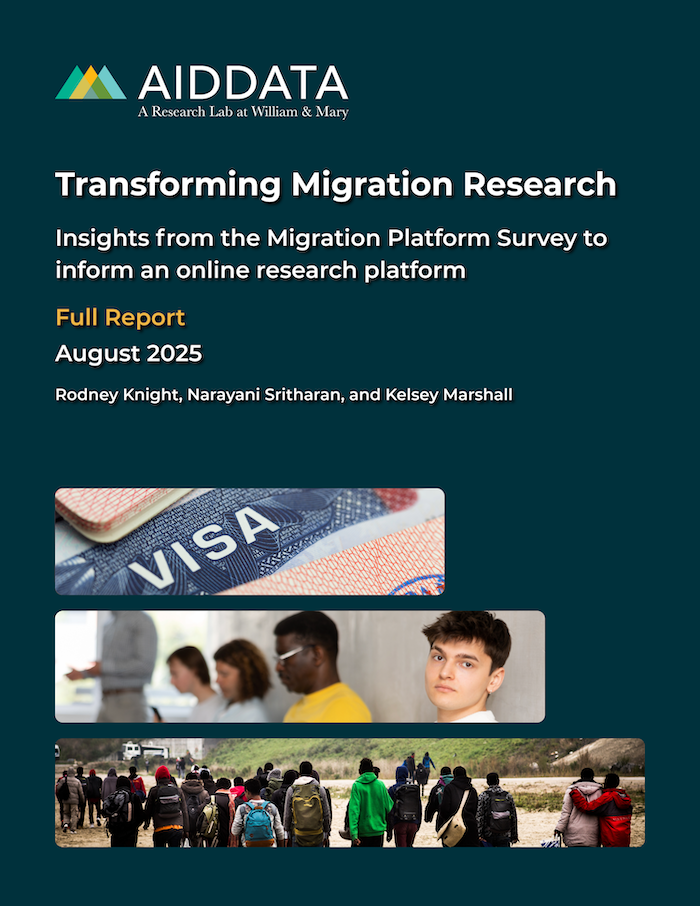Overview
Migration is one of the most pressing and multifaceted challenges of our time, driven by economic opportunities, conflict, climate change, and governance issues.
In the United States, migration policy has become a flashpoint in the national discourse—shaping elections, straining legal systems, and testing the balance between security, humanitarian obligations, and economic need. At a time when the future of key programs like the Special Immigrant Visa is uncertain and public narratives around migration are increasingly polarized, there is an urgent need for rigorous, nonpartisan evidence to inform effective and equitable policy.
Remittances
Supporting millions of households in low- and middle-income countries, driving improvements in education, healthcare, and local economies
We will utilize our expertise in data analysis, household surveys, and econometric methods to investigate the impact of remittances on labor market participation, educational attainment, and household stability, particularly during economic downturns and conflicts. We will generate evidence-based recommendations that help decision makers and practitioners create policies that maximize the economic and social impact of remittance flows, ultimately contributing to more inclusive and sustainable growth in recipient communities. This work is particularly relevant for countries such as Yemen, the Philippines, India, and Mexico, where remittances account for a significant share of GDP and play a crucial role in household survival and local development.
Case Studies and Focus Areas
Do taxes on wire transfers push financial flows off book?
Insights from Yemen
Draw from Yemen paper

Internally Displaced Persons and Refugees
How displacement alters social cohesion and resource allocation in host regions.
The challenge
There are extensive knowledge gaps on the dynamics of forced migration, including the socioeconomic impacts of displacement on host communities and the long-term trajectories of displaced populations.
Our research
By combining household survey data with econometric analysis, we can uncover how displacement affects access to education, employment, and healthcare for internally displaced persons (IDPs) and refugees. We will also explore how displacement alters social cohesion and resource allocation in host regions. We will produce evidence-based recommendations that enable governments, humanitarian organizations, and development practitioners to design interventions that strengthen the self-reliance of displaced populations, while reducing the economic and social strain on host communities. This research can also inform strategies for improving access to rights and services for displaced individuals, ensuring their inclusion in sustainable development efforts. This research is particularly relevant to ongoing crises in Ukraine, Sudan/South Sudan, the Democratic Republic of the Congo (DRC), and Colombia, where displacement is widespread and both long-term and short-term solutions are urgently needed.

South-South Labor Migration
South-South migration constitutes a significant and growing share of global mobility, though the scale of it is largely guesswork
The challenge
The international community has a much deeper understanding of migration from the Global South to the Global North than it does within the Global South. And yet South-South migration constitutes a significant and growing share of global mobility, though the scale of it is largely guesswork, due to the lack of documentation and formal regulation of this movement. These movements challenge conventional narratives of vulnerability, highlighting how migrants exercise agency while navigating complicated systems of opportunity and risk, and how their labor underpins development in both sending and receiving countries.
Our research
We will generate scalable, policy-relevant evidence on South-South labor migration by mapping high-volume corridors, analyzing recruitment practices, and modeling the economic impacts of migration governance reforms. Combining survey data, qualitative interviews, and administrative records, we will examine how policy design in both sending and receiving countries shapes migration costs, contract enforcement, remittance behavior, and migrant well-being. Our focus will center on the Gulf–South Asia corridor, particularly migration flows between Nepal, Bangladesh, India, and countries like Qatar and the UAE, where millions of low-wage workers face high recruitment costs and limited labor protections. Special attention will be given to informal brokerage systems, financial precarity, and access to grievance redress. This research will equip governments, international organizations, and advocacy coalitions with actionable insights to enhance labor protections, develop ethical recruitment systems, and establish migration systems that benefit workers, not just states.

Migration to the U.S.: From Departure to Displacement
the role of diasporas and family networks in facilitating mobility, including how migrants plan their journeys, access information, and determine when and where to relocate
The challenge
In recent years, changing dynamics across Latin America, the Middle East, Africa, and Asia have spurred the emergence of new migration corridors, many of which are directed toward the United States. Economic and political crises in countries like Venezuela, as well as instability in Central America, have shifted the composition of migrants, with an increasing number traveling north from regions that had previously seen lower out-migration.
Our research
We will examine how and why people move, the routes they take (including irregular and dangerous pathways), and the often precarious role of transit countries. We will also investigate how border policies, securitization, and third-country agreements shape decisions and outcomes for migrants along the way. In parallel, we will examine the role of diasporas and family networks in facilitating mobility, including how migrants plan their journeys, access information, and determine when and where to relocate.
We will combine geospatial analysis and social network theory to understand how migrants navigate the journey to the U.S., especially along irregular routes like the Darién Gap, a dangerous corridor between Colombia and Panama. Using satellite imagery, policy data, and migration flow records, we will map how conflict, climate shocks, and border policies influence and reshape migrant pathways over time. Through applying social network theory, we can examine how migrants utilize personal ties and digital platforms to access information, assess risks, and make decisions about when and where to relocate.

Arrival and Belonging: Legal Status, Citizenship, and Integration
guidance on streamlining pathways, reducing bureaucratic barriers, and ensuring more equitable and coherent access to services, ultimately advancing more inclusive and resilient communities
The challenge
Legal status is a critical yet often under-examined factor in determining migrant outcomes. Even among individuals with similar backgrounds, differences in entry pathways—such as asylum, family reunification, or temporary protection—can lead to divergent experiences in employment, education, healthcare, and long-term stability.
Our research
We can leverage this variation to identify which legal frameworks support smoother integration and which create barriers. We will examine how legal status interacts with race, gender, and origin to shape inclusion, as well as how fragmented systems can undermine the well-being and social cohesion of migrants. This work is especially timely in the U.S., in comparing outcomes for Afghan Special Immigrant Visa holders and asylum seekers, and across European countries like Germany, where large numbers of Syrians and Afghans face vastly different integration experiences.
By generating evidence on what works and identifying gaps, we will provide policymakers and funders with practical recommendations to enhance the design and implementation of immigration policies. This includes guidance on streamlining pathways, reducing bureaucratic barriers, and ensuring more equitable and coherent access to services, ultimately advancing more inclusive and resilient communities.

Legal Pathways and Unequal Outcomes: Lessons from Afghan Migration to the U.S.
inform targeted legal advocacy to preserve and strengthen the SIV program, reduce disparities tied to legal status, and support more equitable and coherent immigration policies for future humanitarian arrivals
The challenge
In the wake of the U.S. withdrawal from Afghanistan, thousands of Afghan nationals were promised a pathway to permanent residency through the Special Immigrant Visa (SIV) program. But many have encountered stalled or denied applications due to revised eligibility criteria, missing documentation, or administrative breakdowns. As a result, individuals with nearly identical service records and risk profiles have been funneled into divergent legal pathways, such as asylum or humanitarian parole, that offer less stability and more limited rights. The legal uncertainty is compounded by the looming expiration of the SIV program itself, which could leave thousands of Afghans in legal limbo or at risk of becoming undocumented.
Our research
AidData is leveraging this real-time legal divergence to understand how entry pathways shape early integration outcomes for Afghan migrants in the U.S. In partnership with the William & Mary Immigration Clinic and local resettlement organizations, we are conducting semi-structured interviews and analyzing administrative data to assess differences in access to housing, employment, legal assistance, and long-term security. We also examine gendered dynamics, family separation, and obstacles to status adjustment. The findings will inform targeted legal advocacy to preserve and strengthen the SIV program, reduce disparities tied to legal status, and support more equitable and coherent immigration policies for future humanitarian arrivals.

Online Migration Platform
keeping abreast of current data, methods, and findings becomes increasingly challenging.
The challenge
As migration research rapidly expands across diverse disciplines, keeping abreast of current data, methods, and findings becomes increasingly challenging.
Our research
AidData, in collaboration with Aptima, is developing an innovative online migration research platform designed to centralize resources and facilitate scholarly collaboration. Leveraging advanced AI, including large language models, our platform offers curated access to migration data, methodologies, literature, and networking opportunities. The platform will build upon AidData’s extensive publicly available geographic data in GeoQuery. New and seasoned researchers alike will benefit from accelerated learning curves, reduced research barriers, and enhanced capacity to address critical migration questions. Building upon AidData’s GeoQuery system, this platform promises to significantly advance migration scholarship, policymaking, and practice. AidData envisions several potential components to this project, including a centralized data and methods portal; curated migration datasets with metadata; an AI-enabled literature navigator; collaborative tools for interdisciplinary researchers; training modules; how-to guides for students and early-career scholars; beta testing reports; and public launch events.

Featured Publications
For partnership and media inquiries, contact:

Alex Wooley
Director of Partnerships and Communications










